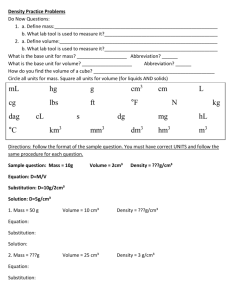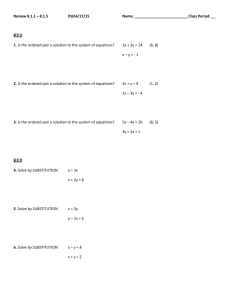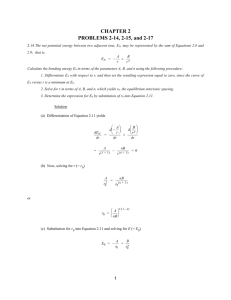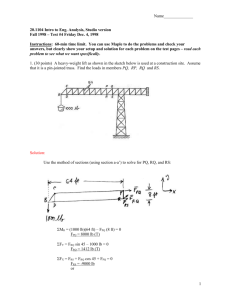Activity 2.1.6 Step by Step Truss System
advertisement
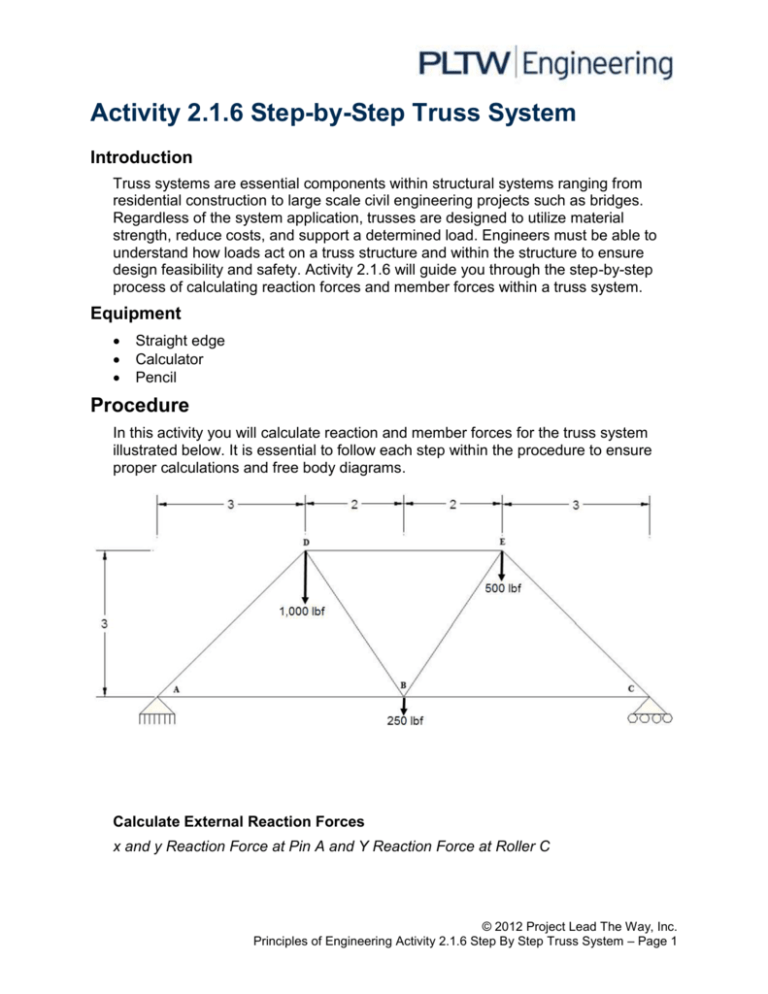
Activity 2.1.6 Step-by-Step Truss System Introduction Truss systems are essential components within structural systems ranging from residential construction to large scale civil engineering projects such as bridges. Regardless of the system application, trusses are designed to utilize material strength, reduce costs, and support a determined load. Engineers must be able to understand how loads act on a truss structure and within the structure to ensure design feasibility and safety. Activity 2.1.6 will guide you through the step-by-step process of calculating reaction forces and member forces within a truss system. Equipment Straight edge Calculator Pencil Procedure In this activity you will calculate reaction and member forces for the truss system illustrated below. It is essential to follow each step within the procedure to ensure proper calculations and free body diagrams. Calculate External Reaction Forces x and y Reaction Force at Pin A and Y Reaction Force at Roller C © 2012 Project Lead The Way, Inc. Principles of Engineering Activity 2.1.6 Step By Step Truss System – Page 1 1. Draw a free body diagram for the entire truss structure illustrated above. Make sure to include all known and unknown angles, forces, and distances. Calculate and determine all angles using trigonometry and geometry. (1 Box = .5 Units) Hints: sin θ = O/H cos θ = A/H tan θ = O/A 2. Calculate reaction forces at the roller and pin connections. a. List static equilibrium equations Hint: . b. List all known and unknown forces acting and reacting on the truss structure Label direction of force with an arrow. i. Forces in the x-direction ii. Forces in the y-direction iii. Moment Forces – Determined from Pin A Formula review: M = Fd © 2012 Project Lead The Way, Inc. Principles of Engineering Activity 2.1.6 Step By Step Truss System – Page 2 c. Solve for RCy by using the moment static equilibrium equation acting upon pin A. Equation Substitution RCy= Simplification Solution d. Solve for unknown reaction force in the x-direction (RAx). Use the sum of forces in the x-direction equilibrium equation. RAx= Equation Substitution Solution e. Solve for unknown reaction forces in the y-direction. Use the sum of forces in the y-direction equilibrium equation. Equation Substitution RAy= . Solution f. Draw a free body diagram for the entire truss system illustrated on page 1. Make sure to include your calculated support reactions (1Box = .5 units). © 2012 Project Lead The Way, Inc. Principles of Engineering Activity 2.1.6 Step By Step Truss System – Page 3 Calculate Individual Truss Member Forces 3. Calculate AD and AB a. Draw the free body diagram for joint A. Make sure to include all known and unknown angles and forces (including x and y vector components). Do not include lengths. b. Use SOH CAH TOA to express ADx and ADy in terms of AD. i. Calculate ADx ADx = Equation Substitution Solution ii. Calculate ADy ADy = Equation Substitution Solution c. List all known and unknown forces. Label direction of force with an arrow. i. Forces in the x-direction ii. Forces in the y-direction © 2012 Project Lead The Way, Inc. Principles of Engineering Activity 2.1.6 Step By Step Truss System – Page 4 d. Use static equilibrium equations to solve for AD and AB. i. Solve for AD by calculating y-direction static equilibrium. Equation Substitution Simplification AD = Simplification Solution ii. Solve for AB by calculating x-direction static equilibrium. Equation Substitution Simplification AB = Substitution – Insert calculated FAD value Solution e. Update the joint A free body diagram with calculated forces for AD and AB. 4. Calculate CB and CE. a. Draw the free body diagram for joint C. Make sure to include all known and unknown angles and forces (including x and y vector components). Do not include lengths. © 2012 Project Lead The Way, Inc. Principles of Engineering Activity 2.1.6 Step By Step Truss System – Page 5 b. Use SOH CAH TOA to express CEx and CEy in terms of CE. i. Calculate CEx CEX = Equation Substitution Solution ii. Calculate CEy CEy = Equation Substitution Solution c. List all know and unknown forces. Label direction of force with an arrow. i. Forces in the x-direction ii. Forces in the y-direction d. Use static equilibrium equations to solve for AD and AB. i. Solve for CE by calculating y-direction static equilibrium. Equation Substitution Simplification CE = Solution © 2012 Project Lead The Way, Inc. Principles of Engineering Activity 2.1.6 Step By Step Truss System – Page 6 ii. Solve for CB by calculating x-direction static equilibrium. Equation Substitution Simplification CB = Substitution – Insert calculated CE value Solution e. Update joint C free-body diagram with calculated forces for CE and CB. 5. Calculate EB and ED a. Draw the free-body diagram for joint E. Make sure to include all known and unknown angles and forces (including x and y vector components). Do not include lengths. b. Use SOH CAH TOA to express EBx and EBy in terms of EB. i. Calculate EBy EBy = Equation Substitution Solution ii. Calculate EBx EBx = Equation Substitution Solution © 2012 Project Lead The Way, Inc. Principles of Engineering Activity 2.1.6 Step By Step Truss System – Page 7 c. List all known and unknown forces. Label direction of force with an arrow. i. Forces in the x-direction ii. Forces in the y-direction d. Use static equilibrium equations to solve for EB. i. Calculate y-direction static equilibrium. Equation Substitution Simplification EB = Substitution ii. Equation Simplification Solution Calculate x-direction static equilibrium. Substitution Simplification ED = Substitution Simplification Solution e. Update joint E free body diagram with calculated forces for EB and ED. © 2012 Project Lead The Way, Inc. Principles of Engineering Activity 2.1.6 Step By Step Truss System – Page 8 6. Calculate DB a. Draw the free body diagram for joint D. Make sure to include all known and unknown angles and forces (including x and y vector components). Do not include lengths. b. Use SOH CAH TOA to express DBx and DBy in terms of DB. i. Calculate DBy DBy = Equation Substitution Solution ii. Calculate DBx DBx = Equation Substitution Solution c. List all known and unknown forces. Label direction of force with an arrow. i. Forces in the x-direction ii. Forces in the y-direction d. Use static equilibrium equations to solve for DB. © 2012 Project Lead The Way, Inc. Principles of Engineering Activity 2.1.6 Step By Step Truss System – Page 9 i. Solve for DB by calculating y-direction static equilibrium. Equation Substitution Simplification DB = Simplification Solution e. Update joint D free body diagram with calculated forces for DB and DE. Draw Completed Free Body Diagram 7. Draw a completed free body diagram for entire truss structure using all calculated reaction and member forces. © 2012 Project Lead The Way, Inc. Principles of Engineering Activity 2.1.6 Step By Step Truss System – Page 10


